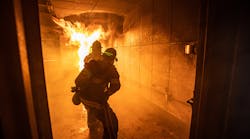In the United States, new high-rise apartments and office buildings continue to grow, along with massive warehouses and other large commercial structures. Part of managing these increasingly larger, more complex facilities is making sure the facilities have appropriate systems in place to help keep firefighters healthy and safe during emergency situations. This helps ensure the responding firefighters can focus on fire attack and helping to get occupants out of the building. Ready access to breathing air for the firefighters is key to this.
Historically, firefighters have had to hand-carry extra air canisters to have access to replenishing breathing air, which can slow fire attack response time. Firefighter Air Replenishment Systems (FARS) are a standpipe system for air, designed to provide a dependable and accessible source of air replenishment to first responders during a large structure fire. A network of pipes, valves and connections comprise the system, delivering air to designated fill stations strategically located throughout a building. FARS replace the slow, labor-intensive hand-delivery of replacement air bottles, both speeding fire attack and search and rescue operations and reducing the risk of exposure to the toxic effects of fire smoke.
As more U.S. states and Canadian provinces move to require FARS in buildings, it is important for building owners and managers to understand what FARS are, how they work, and how they can help keep their facilities prepared for an emergency situation.
How FARS Works
Firefighters can activate the system simply by connecting their self-contained breathing apparatus (SCBA) bottles to the fill station outlets using tubing that is contained inside the fill panel. The system is designed to refill an SCBA in up to two minutes, while the firefighter remains protected under full respiration.
All FARS include an air monitoring system that tracks pressure levels and air quality. Regular maintenance and inspections are required by code to ensure that the system remains operational and in compliance with relevant standards and regulations.
6 Life Safety Benefits of FARS
While FARS was designed to benefit firefighters and emergency responders, building owners also benefit from equipping their buildings with FARS. Benefits include:
1. Enhanced occupant safety. FARS ensures that firefighters have a readily available and continuous supply of breathing air throughout their operations. Lack of ready access to air will slow down critical fire attack operations, like search and rescue.
2. Faster fire suppression. With a FARS in place, firefighters can refill their air cylinders and quickly return to fighting the fire. This puts more firefighters on-scene longer, increasing the speed with which they can suppress the flames.
3. Reduced property damage. Fast, efficient air re-supply contributes to faster fire suppression and containment. The faster the fire can be controlled and extinguished, the lower the amount of property damage and the faster a property can be rehabbed.
4. Compliance with codes and standards. Building codes and standards such as the International Fire Code and Uniform Plumbing Code include guidance on the installation and use of FARS in certain types of buildings. This guidance may be adopted by and turned into requirements for building construction by state and local communities. By implementing FARS, building owners can ensure compliance with requirements, avoiding potential penalties and legal issues.
5. Positive reputation and insurance benefits. Insurance companies often take proactive measures into account when determining risk profiles and rates. Building owners who prioritize firefighter safety and invest in advanced fire protection systems like FARS can enhance their reputation as responsible and safety conscious. This can positively influence insurance premiums and coverage terms.
6. Relationship building with fire departments. Implementing FARS demonstrates a commitment to supporting community safety, local fire departments and their firefighters. Building owners who provide FARS systems in their properties can develop a cooperative relationship with the fire department, leading to improved emergency response and potentially minimizing the impact of a fire incident on their property.
A FARS is a good example of innovative new building systems available to help firefighters and building owners alike. Designed to protect firefighters from the potentially deadly consequences of running out of air and breathing fire smoke, these systems can also benefit building owners, building occupants, and entire communities with enhanced protection, faster response times, and improved safety.



